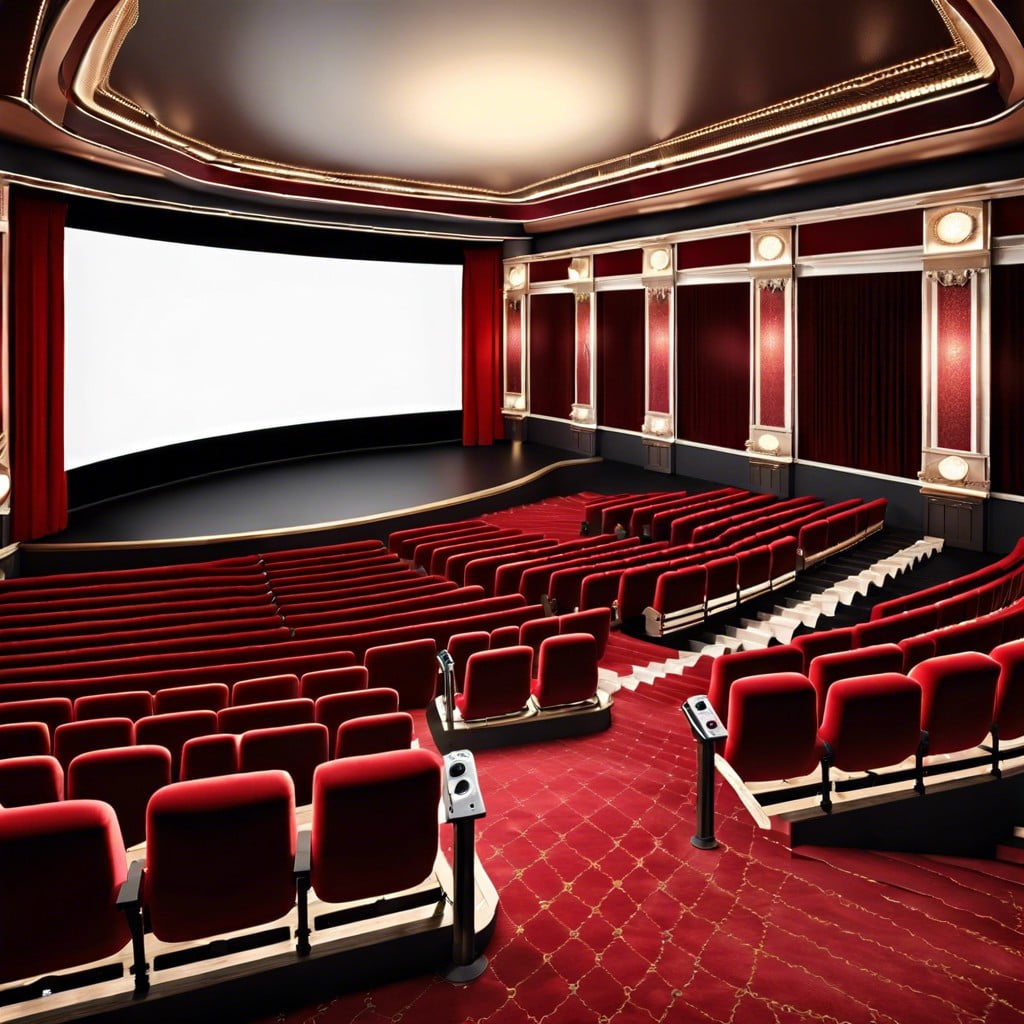Discover the captivating history and evolution of reel theater and understand its significance in today’s entertainment landscape.
Key takeaways:
- Reel theaters use physical film reels for projection.
- They offer a tactile and immersive viewing experience.
- Digital cinema has transformed traditional reel theaters.
- Future trends include AR, AI, sustainability, and luxury amenities.
- Luxury cinemas elevate moviegoing with plush seating and top-tier services.
Definition of Reel Theater

Reel theater, often synonymous with traditional cinema, refers to movie theaters using film reels to project movies. Unlike modern digital systems, reel theaters deploy analog technology, encompassing large reels of film that run through a projector to display images on a screen. This method has a cinematic charm, ringed by the whirr of the projector and the flicker of analogue imagery.
- Key points include:
- Reel theater operates with mechanical projectors.
- The system uses physical film reels made of celluloid.
- Projection involves a play of light through the film, creating moving images.
- This format is valued for its aesthetic qualities and nostalgic appeal.
These theaters offer a tactile and immersive viewing experience, connected deeply with the history of cinema itself.
History and Evolution of Reel Theaters
Reel theaters, originally known as movie palaces, began enchanting audiences in the early 20th century. These venues were grand, often featuring opulent architecture that reflected the excitement of Hollywood. Over the decades, technology advanced, shifting from silent films to “talkies,” which brought synchronized sound and broadened cinema’s appeal.
Post-World War II, societal changes and the advent of television led to a decline in traditional movie palaces. In response, the 1960s and 70s saw the rise of multiplexes and megaplexes—larger sites that could screen multiple films simultaneously, catering to an increasingly diverse audience palette.
During the 1980s and 1990s, the push for better viewing experiences led to significant improvements in sound systems, such as Dolby, and the introduction of stadium seating in some theaters. This era also marked the beginning of the digital projection revolution, gradually phasing out traditional 35mm film reels.
Today, with nostalgia and a nod to cinematic tradition, some theaters have begun reintroducing film reels to offer a vintage movie-going experience, complete with the charm and mechanical flicker of old-school cinemas. This blend of past and present illustrates how reel theaters continue to evolve, striving to offer unique experiences that resonate with cinema lovers.
Impact of Digital Cinema On Reel Theaters
Digital cinema has significantly transformed traditional reel theaters. Firstly, the shift from film to digital projection has streamlined the distribution process. Movies can now be sent digitally, reducing costs and improving accessibility for smaller, independent films.
The quality of viewing has also improved with digital formats. Audiences can enjoy clearer, crisper images and better sound quality, enhancing the overall movie-going experience.
However, this shift has posed challenges for older theaters, requiring them to upgrade equipment, which can be costly. Some have struggled to keep up financially with these modern demands.
Furthermore, the change to digital has impacted the nostalgia and charm associated with classic reel film presentations, potentially alienating certain segments of the audience who cherish the traditional film experience.
Future Trends in Reel Theaters
As technology advances, reel theaters are poised to incorporate more cutting-edge innovations to enhance viewer engagement. Expect to see augmented reality (AR) aspects integrating with traditional film presentations, giving audiences a layer of interactive content that complements the storyline. For instance, viewers might be able to explore a movie’s setting through AR glasses while watching the film, providing a immersive experience.
Artificial intelligence (AI) will likely play a role in personalizing film experiences. AI could suggest movies based on past viewing habits or even adjust the theater environment—lighting, sound, and seat vibrations—to match the intensity of the action on the screen.
Sustainability will also come into sharper focus. More reel theaters are predicted to adopt green technologies, such as energy-efficient projectors and sustainable building materials, minimizing their environmental footprint.
Lastly, the social aspect of movie-going will evolve. Reel theaters might offer more luxury amenities, including gourmet dining options and private viewing pods, to attract those looking for a premium, social viewing experience. This shift acknowledges that theaters are not only about watching movies but also about enjoying a shared cultural event in a comfortable, appealing setting.
The Reel Luxury Cinema Experience
Luxury cinemas elevate moviegoing into an art, blending the nostalgia of classic film reels with contemporary comforts. Here are key elements that define this plush experience:
Firstly, seating radically differs from standard theaters. Armchairs are plush, often leather, and recline, allowing patrons to view their film in supreme comfort. Some venues even provide blankets and pillows for a homelike feel.
Secondly, the quality of services in these theaters is top-tier. From concierge services that assist with reservations and food orders to in-theater dining featuring gourmet menus, every detail is attended to with precision.
Additionally, the ambiance in luxury cinemas is refined and stylish. The decor often features rich, elegant materials and a design that echoes upscale lounges rather than mere movie theaters.
Lastly, technology plays a pivotal role. Enhanced sound systems and superior projection capabilities ensure that even classic reel films are presented with crystal-clear imagery and resonant audio quality, making the experience exceptionally immersive.
In essence, luxury cinemas transform a typical night out at the movies into a cultivated event, where both the environment and the services are crafted to pamper and impress.
